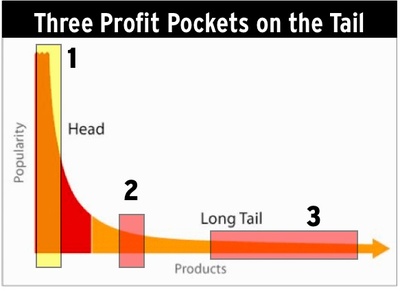Wagging the Long Tail of Love
[Translations: Dutch, Japanese]
Seth Godin has been exploring Chris Anderson’s idea of the The Long Tail. As usual Seth brings clarity and illumination to this often misunderstood notion. He recently posted a dissection of the three “profit pockets” within the Long Tail, which he illustrated like this:

There’s a blatant switcheroo that Seth (and almost everyone else) makes when explaining the Long Tail. In pocket #1 of the curve, Seth talks in terms of a creator of a work. In pocket #2 of the curve, he also talks in terms of the creator. But then when he gets to the long tail, he switches away from a creator, to talk in terms of an aggregator of other creators’ work. Why is that? What happens to the creator? The creator is dropped when we get to the long tail “pocket of profit” because the long tail is not profitable for the creator. It’s profitable only for the audience and aggregators.
I’m not really sure the “fractal long tail which operates within a long tail” (every subject has its own long tail) mentioned in Seth’s previous post helps a whole lot either, other than to say you want to be as close to the head as possible even in your niche. That is a no brainer. Being an aggregator is not an option either for a creator. Almost no creators I know are productive enough to create sufficient quantity of new things to aggregate their own work. Aggregators are by definition not creators.
So as one crosses the sections — going from the short head to the long tail — one should be consistent and view it from the aggregator’s point of view or the creator’s point of view. I think it is a mistake to conflate the two view points.
I’ve been wrestling with this for a while and I think the only advantage to the creator that I can see in the long tail is that aggregators can invent or produce a long tail domain that was not present before. Like Seth’s Squidoo does. Before Squidoo or Amazon or Netflix came along there was no market at all for many of the creations they now distribute. The proposition that long tail aggregators can offer to creators is profound, but simple: you have a choice between a itsy bitsy niche audience (with nano profits) or no audience at all. Before the LT was expanded your masterpiece on breeding salt water aquarium fishes from the Red Sea would have no paying fans. Now you have maybe 100.
One hundred readers/watchers/listeners is not economical. There is no business equation that can sustain profits for continual creation from so few buyers. (It can of course support the business of aggregation above the level of creation.) But the long tail niche creation operates perfectly well in the realm of passion, enthusiasm, obsession, curiosity, peerage, love, and the gift economy. In the exchange of psychic energy, encouragement, meaning of life, and reasons to live, the long now is a boon.
That is not true about profits. Economically, the more the long tail expands, the more stuff there is to compete with our limited attention as an audience, the more difficult it is for a creator to sell profitably. Or, the longer the tail, the worse for sales. But if we view the long tail as a market of a different type, as a market of enthusiasm and connection, then as the long tail expands, this increases the chance of two enthusiasts meeting, and so the longer the tail, the better. The first two pockets of the curve are trying to maximize profits; the last pocket of the long tail is trying to maximize passion and connectivity.
There is one further indirect advantage to the long tail. Since your creation now exists in a market (where it would not have existed at all before) it can, if you are lucky, start to migrate uptail. With creativity you may be able to move your creation out of the economic doldrums of the long tail up into section #2, where 1,000 true fans and other mid-level success lies. As I argue in 1,000 True Fans, this is where you want to be as a creator. Seth calls it the pocket of ” the profitable, successful niche product” and I agree with him that this pocket #2 rather than pocket #1 is where you want to aim for.
But if you fairly evaluate section #3 according to the same metrics as section #1 and #2 — the dollar value to the creator — then the long tail is a desert for profits. It makes sense to pursue this pocket only if you switch. You must switch in pocket #3 either to looking at it from the perspective of an overlord aggregator, OR, you need to switch to looking at this territory as an alternative economy, one that is not running on the dollar. A new region with its own dynamics.
In other words, Squidoo and Amazon and Netflix make the profitable long tail very happy. But happy long tail does not make happy creator.
I prefer to think of the Long Tail as being a tail to a different animal. We’ve misidentified the intangible being it belongs to. It is not the long tail of the Beast of Commercial Profits. Rather it is the long tail of the Dragon of Love. The love of creating, of making, of connecting, of unreasonable passion, or making a difference, or doing something that matters to ourselves, the love of connecting, giving, learning, producing, and sharing.
It is important to know which tail we are wagging.


